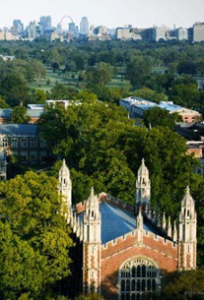
Message From The Dean – Bob Fulcomer
Spring approaches and students start preparing for finals. It is also time for high school juniors to be visiting college campuses. It is very important for students to tour a college campus when students are still there attending classes and other functions. This gives the prospective student “the feel” of the atmosphere, a chance to talk with students that attend the college, and the opportunity to truly evaluate the school and its appropriateness for him/ her. For students that are working with their coach, they should make sure they use the checklists suggesting to whom to speak while making their college visits and what questions to ask. Many times, a student will drop out of college or transfer to a different school after a semester or two because they don’t feel comfortable for a number of reasons. Not only does this affect their grades, but it is also an emotional stress. It can be an additional expense when transferring, and there is a possibility of losing valuable credit hours. This is also a critical time to be enrolling new students into the HIFE CPP in order for the coach to have time to guide them through the visitation process, as well as get them started on applications.
Students Speak: How Campus Visits Helped Me Choose
A campus visit can be a big help — and sometimes a tiebreaker — when you’re deciding on which college to attend.
Q: How did your college visits shape your decision about where to go?
A: After visiting my dream school, I was highly disappointed. Something about the atmosphere and interacting with the students didn’t satisfy me. But when I visited the college I’m at now, I felt an instant sense of comfort. I was able to speak with the diversity- enhancement representatives, and they were extremely nice and welcoming. I knew this was the campus I had to attend, and I do not regret my decision.
—Bianca, college senior
A: Looking online and through college catalogs helped me narrow down which institutions matched my academic needs, but I didn’t realize that [my college] was the place I could call home until I stepped foot on campus and stayed overnight with a student.
—Gregory, college sophomore
A: In the end, the most important thing for me was getting a feel for the environment. Some schools are intensely competitive. Others incorporate two extremes, partying hard and studying hard. The college visit will give you a gut feeling as to what is most comfortable for you.
—Julian, high school senior
Source: bigfuture.collegeboard.org
Why Visit Colleges?
A key part of deciding which college to go to is finding a good fit. And a great way to get more information is to visit the colleges in person.
Of course, visiting colleges may not be possible for everyone, but it’s a good idea to make the trips, if you can. It can help you determine whether a college is the right place for you.
Get a Firsthand View
A campus visit is your opportunity to get a firsthand view of a college. A college catalog, brochure or website can only show you so much. To really get a feel for the college, you need to walk around the quad, sit in on a class and visit the dorms.
Get Answers to Your Questions
A visit also gives you the chance to talk to students, faculty, and financial aid and admission officers. You can get answers to important questions, including:
- What is the average class size and the student-to-faculty ratio? Are most classes taught by professors or by teaching assistants?
- What is the campus meal plan like? How is the food? What are the options?
- What is the makeup of the current freshman class? Is the campus fairly diverse?
- What’s the social scene like? What kinds of activities are available?
- Is there plenty of dorm space or is there a housing crunch?
- How many students are commuters and how many are campus residents?
Use this checklist for campus visits to remind yourself of everything you want to do once you get to campus. Your family members can also participate in the visit and any informational sessions. They can help you think through your decision about which colleges to apply to, and ultimately, which college to attend.
Get Valuable Information
Pick up any official college material you see, such as brochures and financial aid forms. Don’t forget to get business cards, too, so you’ll have a real, live contact if you have a question about admission or financial aid.
Student newspapers and activity calendars give you a sense of what campus life is really like. Check out bulletin boards to see what bands are coming to the campus, what parties are advertised, what internships are posted and generally what the day-to- day energy of the place is.
Get Ready to Decide
Ultimately, it’s your decision. Listen to your gut. Do you feel comfortable walking around campus? Do you feel at home? Do you click with the students and faculty? Is this what you imagined college to be like? Spending time on a campus helps you determine whether a college is a good fit. Source: collegeboard.org
Campus Setting: Rural, Suburban, Urban
Which Is Right for You?
One of the steps in finding the right college for you is deciding what type of campus setting you prefer. Rural, suburban and urban campuses all have different advantages. The key is to find which setting will allow you to make the most of your college experience.
Rural Campuses
Rural campuses are located in the country, often near farms and wilderness areas and usually near a small town. Here are things to consider about rural campuses:
- Most rural campuses are self-contained, with a majority of the students l iving on campus. This can increase a college’s sense of community.
- Rural campuses can provide access to outdoor learning opportunities, particularly in fields like agriculture or environmental science.
- Many rural colleges bring entertainment to their students and provide free events. Comedians and bands may perform on campus during college tours.
- Most rural colleges provide on-campus transportation options, such as buses, for students.
- The landscape of rural campuses can vary widely. A rural campus in Ohio, for example, will be much different from a rural campus in Alaska.
 Suburban Campuses
Suburban Campuses
Suburban campuses are in small cities, large towns or residential areas near cities. Here are things to consider about suburban campuses:
- Suburbs often combine some of the best features of urban and rural areas.
- Suburban campuses usually offer access to nearby cities and to outdoor activities.
- Suburban colleges are frequently self- contained, which can create a strong sense of community.
- Suburban colleges often have connections to the towns where they are located. This can provide opportunities such as jobs and entertainment.
- Public transportation may be available in addition to a college’s transportation options.
Urban Campuses
Urban campuses are located in cities. Here are things to consider about urban campuses:
- Some urban campuses are spread throughout a city while others are self- contained within a city.
- Many urban colleges offer off-campus learning experiences. These may include opportunities to explore the work world through cooperative classes and internships.
- Urban colleges tend to attract culturally diverse students.
- Students can find entertainment options — such as museums, concerts and plays — on and off urban campuses.
- Cities usually offer strong public- transportation options.
Source: bigfuture.collegeboard.org
When to Visit
It’s best to visit when the college is in session. That way, you’ll get to see it when classes are meeting and day-to-day activities are taking place.
How to Pick a Date
Plan your visit well ahead of time, so you can make sure that you see what you need to see and meet with the people who can tell you what you need to know.
During the Week
Mondays through Thursdays are ideal for visits since campuses are generally in full swing. Visiting on a Friday may not be as practical, as students, faculty and staff might be busy with social activities starting Friday afternoon.
High school holidays that fall on Mondays are often great opportunities for making college visits. Many colleges are in session on these days — and you won’t be missing any of your high school classes.
The Best Seasons
The late summer and early September before senior year are convenient times to visit, since many colleges begin their fall semester as early as mid-August. The spring of junior year is a good time if you’ve already researched colleges. Spring break is also good if you play fall sports or are considering applying under early action or early decision plans, which usually have application deadlines in November of senior year.
It may be more useful for seniors to wait until the fall through winter to make their visits. That timing can help seniors narrow college lists.
Source: Zola Dincin Schneider
Coach’s Corner
The SAT has been revised and the new version is scheduled to be introduced in March 2016. Students who take the SAT this fall will be taking the old version of the exam; starting in March, the new version will be the only version offered. The College Board has been working with Khan Academy to prepare study materials for the new SAT and those materials will be available beginning in June 2015.
Students applying for college admission in 2016 can use scores from either the old or the new test; if students take both tests, they should submit both sets of scores.
Colleges have a scoring matrix that shows the correlation between the scores on both versions of the exam.
It’s anticipated that beginning with the 2017 school year, nearly all students will use only scores from the new version of the test.
Check the website www.khanacademy.org for information about the SAT and for study materials as they become available.


